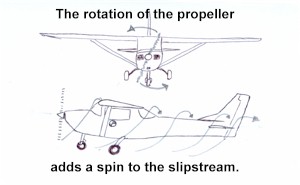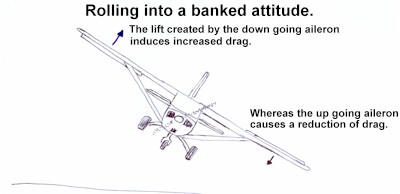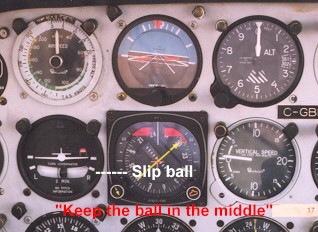
We have learned how to cruise, climb, descend, and turn to a basic level and now we are going to learn that it’s not that simple. Because the aeroplane has a propeller, and has ailerons, it suffers from effects known as slipstream, gyroscopics, and adverse yaw. In this lesson we will learn how we control these effects by using the rudder.
Now we are getting deeper into this flying business, I’d better give you some more definitions.
Slipstream.
Because the propeller spins this causes the air to spin as well and so the air moves backwards in a spiral around the fuselage of the aeroplane, this airflow behind the propeller is called the Slipstream.

Gyroscopics.
When riding your bicycle you probably notice that when you lean to one side the bicycle tends to turn in the same direction! This is due to gyroscopic Precession whereby a force acting on any part of the rim of a spinning wheel will be translated into a reaction 90° to the position of that force. So if the wheel is rotating in the direction the bicycle is traveling and a force is applied to the top to push it over, this will cause the wheel to turn instead! Leaning to the left is like pushing the top of the wheel to the left, this force goes through 90° causing the wheel to turn and steer the bicycle to the left.
A propeller behaves like a gyroscope because it spins like the wheels on your bicycle.
To generate lift we have to move air downwards, and to roll into a banked attitude to turn we have to lift one wing while dropping the other. To lift a wing we have to generate more lift and so we lower the aileron on that side, we don’t get something for nothing and so this extra lift increases the Drag, meanwhile dropping the other wing by moving the aileron upwards reduces the drag. The increased drag generated by the down going aileron causes the nose to yaw in the opposite direction to the roll and this is called Adverse Yaw.

Controlling Yaw.
Slipstream, gyroscopics, and adverse yaw all try to point the nose away from the desired direction; this increases the drag, and is therefore not a desirable thing. We control yaw by using the rudder. The aeroplane has a simple ball in an inverted glass tube to indicate unwanted yaw, this is called a Slip Ball and we keep this “ball in the middle” unless it suits us to increase the drag by slipping!

A good way to detect unwanted
yaw is by looking ahead when you roll the aeroplane.
Pick a point straight ahead and try to roll the aeroplane while
keeping this point in the same position in the windscreen, if you
can do this you are doing a coordinated entry into a banked
attitude.
In the last lesson we learned to turn using the ailerons to roll the aeroplane into a banked attitude, and the elevator to raise the nose slightly to maintain the required lift by increasing the wings’ angle of attack. But the rudder plays an important part here as well. As we roll into the turn adverse yaw will try to point the nose in the wrong direction and so we will need to apply rudder in the direction of the turn as we roll. Once we are established in the turn the design of modern ailerons is such that adverse yaw is greatly reduced and we may not need to continue to apply rudder to keep the ball in the middle.
The slipstream will try to yaw the aeroplane when the airspeed is changed. This is especially true when we are climbing at high power and low airspeed. As a rule, in the Cessna 152, which has a propeller that rotates to the right (as viewed from behind), you will need to apply some right rudder to keep the ball in the middle.
In the next lesson we will look at flight at reduced airspeeds.
© Michael Peare 2015